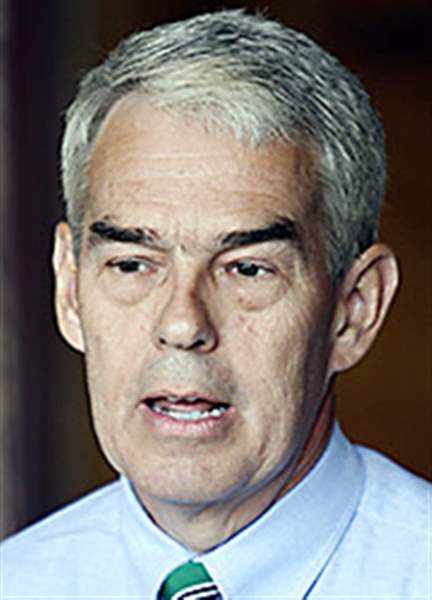
Dredging bill advances
Measure could fund alternative uses for silt
11/15/2013
Gardner
THE BLADE
Buy This Image

Gardner
Ohio governors and environmental regulators have tried for nearly 30 years to stop the Army Corps of Engineers from putting sediment it dredges from the Toledo shipping channel back into western Lake Erie, fearing the nutrient-enriched particles hurt fish and worsen the lake's toxic algae problem.
Now, for the first time, the Ohio General Assembly could pass legislation to help deter the practice.
Under an amendment inserted into a broader agricultural runoff bill Wednesday, Sen. Randy Gardner (R., Bowling Green) sought up to $1 million from a stagnant land-conservation program to help reduce open-lake disposal of silt and soil.
The Corps pulls the material out of the Maumee River and Maumee Bay every summer to help unclog Toledo's shipping channel.
The Toledo channel is the most heavily dredged in the Great Lakes region because of western Lake Erie's shallowness and the region's abundance of farms. Tons of soil blow off northwest Ohio farms and some lands in the channel.
Mr. Gardner's plan is to divert unused money from the state's Conservation Reserve Enhancement Program into the Healthy Lake Erie Fund. The conservation fund offers incentives to farmers who create buffer strips, install windbreaks, and take other measures to keep soil from leaving their land. But participation in it has slowed, Mr. Gardner said.
The $1 million to help deter open-lake disposal would be among $1.6 million of unused funds the senator wants diverted. About $600,000 would go toward programs undertaken by area soil and water conservation districts, which also can include planting more cover crops.
State officials have been negotiating with the Corps to reduce open-lake disposal almost since the federal agency began hiring contractors in the 1980s to redeposit the sediment into the Maumee Bay.
Pressed by fishery biologists, governors from Michigan and Ohio have tried to end the practice.
The Ohio Environmental Protection Agency, which issues the dredging permits to the Corps, has tried to impose stricter permits. Those efforts were nullified when the Corps successfully appealed before a state review board.
Bruce Sanders, a Corps spokesman, could not be reached for comment.
The Corps argues that there are no other feasible options to dredging other than letting the channel clog, a move that could lead to a significant decline in shipping and wreak havoc on the Toledo-area economy.
About 10 percent of what the Corps dredges is placed into an enclosed waterfront disposal facility, which is nearly full. Toledo and Ohio can't afford the nonfederal match required to build a new one.
Now, for the first time, legislation has emerged that could alleviate the problem.
The measure, if approved by the Senate and House, could reach Gov. John Kasich’s desk before the end of the year, Mr. Gardner said.
That would give state officials time to set up a 2014 pilot project exploring a beneficial reuse of dredged material.
One possible use would be placing the soil on area farms instead of putting it back into the water, Mr. Gardner said.
Some money would be devoted to research.
“We think, at the very least, we're going to get their attention,” Mr. Gardner said of the Corps. “It doesn't mean we have a solution, but it does mean we are taking the situation seriously.”
Scientists who track western Lake Erie algae blooms claim this summer's algae problem was the second worst in several decades. Open-lake disposal is seen as a contributing factor.
“We want to be more aggressive about solving the problem,” Mr. Gardner said. “This year was really disappointing.”
Mr. Gardner's amendment is supported by the state's largest environmental group, the Ohio Environmental Council.
Kristy Meyer, the council's managing director of agricultural, health and clean water programs, called it “a step forward towards ending this harmful practice that lowers water quality and property values and exacerbates the harmful algal bloom problem in the western Lake Erie basin.”
Jim Zehringer, director of the Ohio Department of Natural Resources, agreed.
“This will be an important first step in addressing a possible alternative to the open lake disposal of dredge material and the associated nutrients that can impact Lake Erie,” Mr. Zehringer said.
On Wednesday, the U.S. EPA announced a $600,000 grant for the Ohio Lake Erie Commission's efforts to combat western Lake Erie's algae. The commission is a source of grants for many northwest Ohio university researchers.
That money is coming from President Obama's Great Lakes Restoration Initiative.
Contact Tom Henry at: thenry@theblade.com or 419-724-6079.